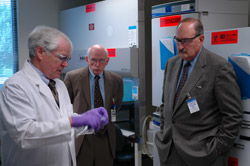![]()
Newly Reestablished Lab is Latest International Resource in War on Terrorism
Mass casualties. Overburdened emergency response systems. Spreading contamination.
As the threat of terrorism—nuclear terror attacks in particular—becomes more credible, a serious gap exists in the United States’ ability to respond effectively. A radiological/nuclear event could expose a civilian population to large amounts of ionizing radiation.

Dr. Gordon Livingston (left) demonstrates the process used for analyzing blood samples at the Cytogenetic Biodosimetry Laboratory for Dr. Robert Brown (center), chief operating officer of DOE-ORO, and Admiral Joseph Krol (right), associate administrator of NNSA’s Emergency Operations. Admiral Krol and Dr. Brown toured the lab as part of a formal dedication event held on the ORISE South Campus in Oak Ridge, Tenn., on March 30, 2007.
However, a newly reestablished lab at the Oak Ridge Institute for Science and Education (ORISE)—the Cytogenetic Biodosimetry Laboratory (CBL)—will play a crucial role in bridging the gap.
The CBL will contribute to the health and safety of the U.S. population by mitigating the effects of such an attack, according to Admiral Joseph Krol, associate administrator for the National Nuclear Security Administration’s (NNSA) Emergency Operations, and Robert Brown, chief operations officer of the Department of Energy’s Oak Ridge Operations (DOE-ORO).
On March 30, 2007, Krol and Brown were featured speakers at a formal dedication ceremony on the ORISE South Campus, which included guided tours of the CBL.
During the ceremony, the CBL was recognized for its importance as not only a valuable addition to the arsenal of national defense resources located in Oak Ridge, but also as an international emergency response resource for radiation dose analysis.
In the event of a mass casualty incident involving radiation, civilians would not likely be wearing dosimeters, which would provide an estimation of the radiation dose that the individuals received. As CBL Director Dr. Gordon Livingston, Ph.D., pointed out, however, the human body has “biological dosimeters” in the form of chromosomes.
“Extensive research has shown that energy associated with ionizing radiation is capable of damaging chromosomal DNA in cells and tissues in a dose-dependent manner,” Livingston said.
The capability to study chromosomal aberrations resulting from radiation exposure—a process referred to as cytogenetic biodosimetry—will greatly assist the medical community in the evaluation, triage, and management of victims with radiation injuries.
Until the late 1990s, ORISE maintained a leading radiation cytogenetics laboratory under the direction of Dr. Gayle Littlefield. This laboratory achieved national and international prominence in radiation effects research and provided many dose estimates for individuals accidentally exposed to radiation.
Although Dr. Littlefield and her colleague Dr. Al McFee are now retired, both individuals serve on the CBL’s scientific advisory board. In addition, ORISE has some of the best-qualified medical and technical personnel available, including Livingston, a nationally respected cytogenetic research leader, and REAC/TS Director Dr. Albert Wiley, M.D., Ph.D.
“ORISE is uniquely qualified to serve as the lab’s home due to the organization’s long history of providing support to medical emergency response personnel who treat those exposed to radiation,” said Brown.
The new laboratory is also fortunate to have the microscopes and related equipment once used by the former laboratory. Complementary to the existing equipment is a new motorized Zeiss microscope coupled with a slide changer, which automatically locates chromosomes of interest on a microscope slide and can scan slides unattended overnight.
The slide changer can hold, and scan, up to 80 slides—each one containing from 300-1,500 dividing lymphocytes. The ability to quickly scan slides unattended greatly improves the processing time and hence the response time for treatment of those with radiation injuries.
“We decided that the CBL was necessary to ensure the United States is prepared for a mass exposure incident, and then we worked to ensure that the appropriate funding and support was in place,” said Krol.
Funding for the reestablishment of the CBL was provided by DOE’s NNSA and the Office of Worker Safety and Health, as well as the U.S. Nuclear Regulatory Commission.
The CBL will be operated as a part of the Radiation Emergency Assistance Center/Training Site (REAC/TS). As the lab becomes more established, it will serve as a resource for other cytogenetic laboratories.
Collaborations could extend to international laboratories to validate methodologies and results of blind samples.
The lab will also likely work with the Armed Forces Radiobiology Research Institute—the only other federally funded lab of this kind—to provide cytogenetic sample analysis.
The applications of such a lab are far-reaching, according to Krol, and address a rapidly emerging need for the effective medical response to mass exposure of civilians to radiation.
